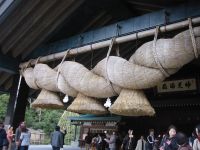
Shimenawa
Encyclopedia

Rice
Rice is the seed of the monocot plants Oryza sativa or Oryza glaberrima . As a cereal grain, it is the most important staple food for a large part of the world's human population, especially in East Asia, Southeast Asia, South Asia, the Middle East, and the West Indies...
straw
Straw
Straw is an agricultural by-product, the dry stalks of cereal plants, after the grain and chaff have been removed. Straw makes up about half of the yield of cereal crops such as barley, oats, rice, rye and wheat. It has many uses, including fuel, livestock bedding and fodder, thatching and...
rope
Rope
A rope is a length of fibres, twisted or braided together to improve strength for pulling and connecting. It has tensile strength but is too flexible to provide compressive strength...
used for ritual
Ritual
A ritual is a set of actions, performed mainly for their symbolic value. It may be prescribed by a religion or by the traditions of a community. The term usually excludes actions which are arbitrarily chosen by the performers....
purification in the Shinto
Shinto
or Shintoism, also kami-no-michi, is the indigenous spirituality of Japan and the Japanese people. It is a set of practices, to be carried out diligently, to establish a connection between present day Japan and its ancient past. Shinto practices were first recorded and codified in the written...
religion. They can vary in diameter from a few centimetres to several metres, and are often seen festooned with shide
Shide (shinto)
is a zigzag-shaped paper streamer, often seen attached to shimenawa or tamagushi, and used in Shinto rituals. A popular ritual is using a haraegushi, or "lightning wand", named for the zig-zag shide paper that adorns the wand. A similar wand, used by miko for purification and blessing, is the gohei...
. A space bound by shimenawa often indicates a sacred
Sacred
Holiness, or sanctity, is in general the state of being holy or sacred...
or pure space, such as that of a Shinto shrine
Jinja (Shinto)
A Shinto shrine is a structure whose main purpose is to house one or more Shinto kami....
.
Shimenawa are believed to act as a ward
Magic (paranormal)
Magic is the claimed art of manipulating aspects of reality either by supernatural means or through knowledge of occult laws unknown to science. It is in contrast to science, in that science does not accept anything not subject to either direct or indirect observation, and subject to logical...
against evil
Evil
Evil is the violation of, or intent to violate, some moral code. Evil is usually seen as the dualistic opposite of good. Definitions of evil vary along with analysis of its root motive causes, however general actions commonly considered evil include: conscious and deliberate wrongdoing,...
spirits and are often set up at a ground-breaking ceremony before construction begins on a new building. They are often found at Shinto shrines, torii
Torii
A is a traditional Japanese gate most commonly found at the entrance of or within a Shinto shrine, where it symbolically marks the transition from the profane to the sacred...
gates, and sacred landmarks. They are also used to mark trees that are believed to be inhabited by spirits called Kodama
Kodama (spirit)
A is a spirit from Japanese folklore, which is believed to live in certain trees .Cutting down a tree which houses a kodama is thought to bring misfortune, and such trees are often marked with shimenawa rope....
. Cutting down these trees is thought to bring misfortune.
A variation of the shimenawa is used in sumo wrestling by yokozuna (grand champions) during their entrance ceremonies to denote their rank.
Further reading
- Kasulis, Thomas P. (2004). Shinto: The Way Home. University of Hawaii Press. ISBN 0-8248-2794-5.

